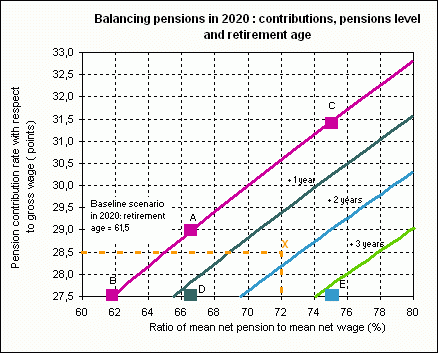Pensions : three policy levers

Reading the graph
This graph is a calculation chart which shows the various options for balancing the French pensions system by 2020. It summarizes the range of different policies that could be implemented.
To reach equilibrium, we can act upon one or more of the following policy levers: level of pensions with respect to wages (x-axis), level of contributions (y-axis), retirement age (diagonal lines).
All points on this graph represent a balanced situation in 2020. We are free to choose two criteria, and the third is imposed by these first two choices. For example, the point of equilibrium X corresponds to a contribution rate of 28.5% (one point higher than the rate in 2003) and a pension level correponding to 72% of wages (three points below the ratio of 2003). To achieve equilibrium, age at retirement must be raised by 1.75 years with respect to the baseline scenario, which is already calculated for a retirement age higher (61.5 years old in 2020) than that of 2003 (60.9).
Higher contributions, lower pensions or later retirement
Point A represents the French Pensions Advisory Council’s baseline scenario which is based on the new rules laid down in 2003, on current demographic trends and on specific economic assumptions. To achieve equilibrium in 2020, it provides for an increase in retirement age, a reduction of the pension/wages ratio to 67% and a 1.5 point increase in contribution rates. The line BC gives the range of possible combinations of contributions increases and reductions in the pension/wage ratio if retirement age is not increased any further.
Increasing the retirement age makes new scenarios possible. A further increase of three years is needed if the other parameters are to stay the same (point E). All intermediate solutions are also possible (points X or D for example).
Sources
This graph is taken from the fourth report of the French Pensions Advisory Council (Conseil d’orientation des retraites, COR), published in January 2007
